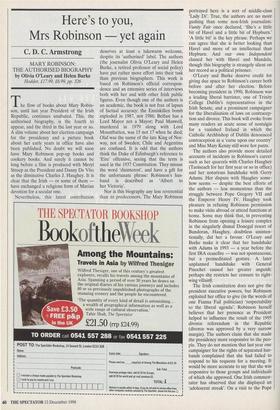Here's to you, Mrs Robinson — yet again
C. D. C. Armstrong MARY ROBINSON: THE AUTHORISED BIOGRAPHY by Olivia O'Leary and Helen Burke Hodder, f17.99, f6.99, pp. 326 The flow of books about Mary Robin- son, until last year President of the Irish Republic, continues unabated. This, the authorised biography, is the fourth to appear, and the third in the last year or so. A slim volume about her election campaign for the presidency and a picture book about her early years in office have also been published. No doubt we will soon have Mary Robinson pop-up books and cookery books. And surely it cannot be long before a film is produced with Meryl Streep as the President and Danny De Vito as the diminutive Charles J. Haughey. It is clear that the Irish — or some of them have exchanged a religious form of Marian devotion for a secular one.
Nevertheless, this latest contribution deserves at least a lukewarm welcome, despite its 'authorised' label. The authors (the journalist Olivia O'Leary and Helen Burke, a retired professor of social policy) have put rather more effort into their task than previous biographers. This work is based on Robinson's official correspon- dence and an extensive series of interviews both with her and with other Irish public figures. Even though one of the authors is an academic, the book is not free of lapses of factual accuracy: the Enniskillen bomb exploded in 1987, not 1986; Belfast has a Lord Mayor not a Mayor; Paul Maxwell, murdered in 1979 along with Lord Mountbatten, was 15 not 17 when he died; Olaf was the name of the late King of Nor- way, not of Sweden; Chile and Argentina are confused. It is odd that the authors think the Duke of Edinburgh's reference to `Eire' offensive, seeing that the term is used in the 1937 Constitution. They misuse the word 'disinterest', and have a gift for the unfortunate phrase: Robinson's hus- band is described as 'Albert to her Victoria'.
Nor is this biography any less reverential than its predecessors. The Mary Robinson portrayed here is a sort of middle-class `Lady Di'. True, the authors are no more gushing than some non-Irish journalists. Vanity Fair once declared, 'She's a little bit of Havel and a little bit of Hepburn.' `A little bit' is the key phrase. Perhaps we can agree that she is better looking than Havel and more of an intellectual than Hepburn. And our own Independent classed her with Havel and Mandela, though this biography is strangely silent on her record as a political prisoner.
O'Leary and Burke deserve credit for giving due space to Robinson's career both before and after her election. Before becoming president in 1990, Robinson was a leading liberal barrister, one of Trinity College Dublin's representatives in the Irish Senate, and a prominent campaigner for the liberalisation of laws on contracep- tion and divorce. This book will evoke from many readers an acute sense of nostalgia for a vanished Ireland in which the Catholic Archbishop of Dublin denounced contraception as a 'curse upon our country' and Miss Mary Kenny still wore hot pants.
The authors also provide more detailed accounts of incidents in Robinson's career such as her quarrels with Charles Haughey (Taoiseach for her first year or so in office) and her notorious handshake with Gerry Adams. Her dispute with Haughey some- how seems — despite the best efforts of the authors — less momentous than the struggle between Pope Gregory VII and the Emperor Henry IV. Haughey took pleasure in refusing Robinson permission to make visits abroad or attend functions at home. Some may think that, in preventing Robinson from opening a leisure complex in the singularly dismal Donegal resort of Bundoran, Haughey, doubtless uninten- tionally, did her a favour. O'Leary and Burke make it clear that her handshake with Adams in 1993 — a year before the first IRA ceasefire — was not spontaneous, but a premeditated gesture. A later unplanned handshake with General Pinochet caused her greater anguish; perhaps she restricts her censure to right- wing villainy.
The Irish constitution does not give the president executive powers, but Robinson exploited her office to give (in the words of one Fianna Fail politician) 'respectability to the liberal agenda'. Robinson herself believes that her presence as President helped to influence the result of the 1995 divorce referendum in the Republic (divorce was approved by a very narrow margin). The authors claim that she made the presidency more responsive to the peo- ple. They do not mention that last year one campaigner for the rights of separated hus- bands complained that she had failed to respond to his requests for a meeting. It would be more accurate to say that she was responsive to those groups and individuals of which she approved. One Irish commen- tator has observed that she displayed an `adolescent streak'. On a visit to the Pope she took delight in appearing not in the customary veil and black dress but in a green dress with a sprig of mimosa to mark International Women's Day. It is question- able whether she should have used her office pour epater le clerge.
Robinson's real significance lies not so much in what she did as in what she came to symbolise, namely a change in public attitudes at home and a new-found Irish confidence — or over-confidence abroad. She tried to annex the position of moral authority once occupied by the Catholic Church in Ireland. Robinson her- self is a Catholic of a somewhat nebulous sort. (It is no surprise to discover that she is on good terms with the Swiss Catholic enfant terrible, Hans Kung.) The authors describe her exactly when they refer to `that lost nun in Mary'. But it is not clear whether the Irish have done well in exchanging secular for religious sanctity.











































































 Previous page
Previous page